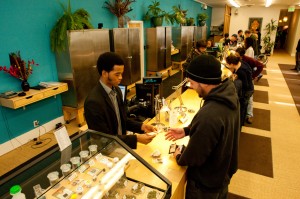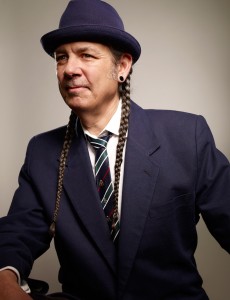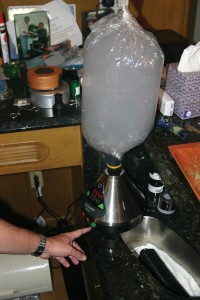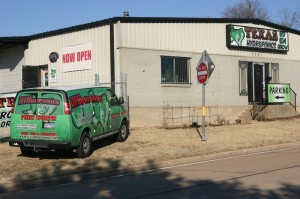The United States economy has struggled in the new century, with manufacturing jobs being shipped overseas, cheap imports flooding stores, and Wall Street reeling wildly at times. But the country has excelled in at least one area: Our reputation for producing bodacious buds has soared.

“California grows the best pot in the world, even rivaling Amsterdam,” J.R. said. “It’s a science, and that’s why I went to school — to learn that science.”
Oaksterdam University bills itself as the country’s “first and premier cannabis college.” Medical marijuana activist Richard Lee founded the school in 2007 after attending a similar one in Amsterdam. Courses covered horticulture, legal issues, politics, and every aspect of the marijuana trade. Interest from potential students was so strong that a waiting list quickly formed. Satellite campuses soon opened in Los Angeles and Sebastopol, and the original Oakland site moved into a larger, 30,000-square-foot campus with classrooms, auditoriums, and a grow lab.
“[Almost] everything I get is from California,” J.R. said on a recent afternoon as he kicked back in his living room. “I will not buy anything else because they know how to grow pot out there. It’s medicinal quality. Street quality is what you get out of Mexico.”
Graduation from Oaksterdam marked J.R. as something of an expert. But attending school there isn’t without danger: The U.S. Drug Enforcement Agency and federal marshals raided Oaksterdam last year, confiscating computer records. J.R. now worries that he might be on a federal watch list.
California law allows medicinal marijuana to be grown and dispensed, but federal law doesn’t. Law enforcement agents have closed an estimated 600 dispensaries in California in the past year and about 1,000 nationwide, said Steve DeAngelo, who founded the largest of them all, Harborside Health Center.
The steady production of high-powered pot, however, continues to roll. Too many growers in too many states have made it tough for feds to stem the tide, particularly when more than half the country frowns on the crackdowns. Domestic pot is a fast-moving train.
“Cannabis remained pretty much the same for 10,000 years until it hit American ingenuity, and then everything changed,” DeAngelo said.

Presidential administrations dating back to Richard Nixon have sunk vast resources into thwarting marijuana smugglers. The U.S. Navy helped block the flow from Colombia and Jamaica, while Customs and Border Patrol watched the Rio Grande. So pot enthusiasts, Californians mostly, began to grow their own. Backyards and fields, even secluded areas of city, state, and national parks, became private gardens.
By the 1990s, the secret was pretty much out, and growers were moving indoors. Equipment was cost-prohibitive in the early years, keeping many wannabe farmers out of the game. But equipment prices slowly dropped, technology improved, and now a person can build a decent grow room for about $2,000.
“The reason you are starting to see a lot of well-grown pot in Texas is because of the number of people growing cannabis under high-intensity lamps,” DeAngelo said. “Once Americans started growing cannabis for themselves, we brought the same ingenuity that we bring to everything else. … Americans went all over the globe searching for the best cannabis strains.”
And just as some Americans enjoy a well-stocked cellar with a variety of wines, pot connoisseurs like to have a cross-section of cannabis. Crossbreeding makes possible a variety of potencies and changes the look, smell, and taste of the plant.
DeAngelo’s dispensary offers 250 varieties and numerous methods of ingestion –– liquids, edibles, capsules, sprays, and, of course, good old-fashioned weed. Or rather, good new-fashioned weed.
White Widow Maker too intense for you? No problem. Chill out with Beauty instead.
By 2010, the yuppie-hipster pot movement was entrenched even in conservative strongholds like Texas. While Mexican weed once represented close to 99 percent of the country’s pot supply, now it’s about 50 percent, DeAngelo estimated. Most dirt weed goes to the same poorer neighborhoods where the cartels move harder drugs such as methamphetamine and crack cocaine.
“Times are changing,” said a young man behind the counter at a local hydroponics store.
Asked to describe his typical customer, he was at a loss for words at first.
“It’s a diverse crowd — young, old, soccer moms, businessmen who want to grow their own stuff. Plus, people want to use it for food growth because they want to know what they’re eating.”
Cartels have responded by entering the hydro marketplace, buying homes in American cities, and establishing covert grow rooms. They’ve also sent illegal immigrants to plant seeds in national parks and forestland and to camp out nearby to tend to the crops.
The free-market system prompted competition and increased product, and prices have slowly dropped.
“There are still people who want Pedro, but I think that market is dwindling,” a local pot dealer said. “There’s been in influx of medium-grade pot –– I call it Pretendica –– that looks good and smells good, but it’s not quite as high quality as somebody’s indoor hydro. It goes for a cheaper price but not as cheap as Mexican weed. You might be able to get a $50 sack of Pretendica versus a $100 sack of hydro.”
********

J.R. knows how to set up a grow room and develop potent strains with the exactness of a scientist and the palate of a connoisseur. He’s also a businessman with an eye out for profit-making ventures.
Texas isn’t on the verge of legalizing medicinal pot as 18 other states have done, but all states will get there one day, he said. Half of American residents lean toward decriminalization for medicinal use. Federal law will eventually change and prompt the remaining holdout states to follow suit, he predicted.
Then J.R. will pounce.
“My goal is to have the very first dispensary in Fort Worth when the time comes, when federal law makes it possible,” he said. “There is a very big pot-smoking population in Texas.”
J.R. loaded a bowl of Blueberry Kush ($20 a gram) into his top-of-the-line Volcano vaporizer ($600) and turned a knob to heat up the device to 395 degrees Fahrenheit. Then he attached a plastic bag on top to catch the vaporized THC coming from the bowl. Vaporizing, or “vaping,” marijuana rather than burning it is easier on the lungs.
“You don’t get any carcinogens,” he said.
Suddenly, vapors began escaping.
“Oops, I’ve got a major leak,” he said, quickly puffing on the bag’s plastic mouthpiece and inhaling deeply. After a few seconds, the bag was empty and his lungs were full.
“There is no burning feeling in my throat at all,” he said after finally exhaling.
After a couple of tokes, his eyelids drooped slightly, even as his gaze became brighter. He doesn’t fit the old pothead stereotype. He’s neither longhaired nor lazy. He’s a 50-something guy who owns a business and two homes, travels frequently, and dresses neatly.
His plan is to teach others how to set up grow rooms and create potent plants. Then those growers can provide him with the weed for his future Cowtown dispensary. He’d rather focus on selling than growing.
“To grow medicinal-grade marijuana is a 24-7 job,” he said. “It’s babysitting. If you have a system and the power goes off all of a sudden and your irrigators don’t irrigate in time or your lights don’t turn on when they’re supposed to, you just screwed up your plants.”
He recommends backup systems in case of power failures and ventilation to control hydro’s strong stench, and he’s got a number of tips for growing top-shelf ganja. Cannabis takes about 14 weeks to mature and flower, then you harvest it and start over again.
Establishing a network of growers will take a while, but J.R. is in no hurry. He figures it will take five, maybe 10 years before medicinal marijuana is legalized in Texas.

That may seem far-fetched to some but sounds about right to NORML attorney Sloane.
“People who favor decriminalization are still in a minority,” he said. “Texas is at about 48 percent. I figure in the next five to 10 years we’re going to be in the majority.”
That percentage jumps to about 85 percent in favor of legalizing medicinal use.
“It’s coming for Texas,” he said. “In four years it’s going to be an issue on the [legislative] table. I predict we’re going to see some dramatic changes within the next eight years.”
Previous bills have died in committee, but a few politicians keep pushing. State Rep. Elliott Naishtat (D-Austin) has filed a medical marijuana bill in the current legislative session.
“It doesn’t legalize anything, because that wouldn’t stand a snowball’s chance of passing,” he said.
Under the bill, the “patient would be authorized to prove in court that he or she is suffering from a bona fide medical condition and that a licensed doctor has recommended marijuana as an option to alleviate the symptoms.”
If the bill become law, sick people with doctors’ recommendations to use marijuana might still be arrested, but they could go to court, and “the judge would be able to say, ‘Go home, go home,’ ” Naishtat said.
Sloane doesn’t advocate marijuana use, but he too considers current laws as flawed and would like to see them changed. Whether voters are ready is another story.
“I don’t think it’s going to fly yet,” he said.
He joined NORML to push for new laws because taxpayers are “sick of paying for the prosecutions of people who possess a flower,” he said.
Politicians who lean toward legalization include Republican U.S. Sen. Ron Paul of Texas, a 2012 presidential candidate, and his son Rand Paul, a Republican senator from Kentucky who is considering a presidential run in 2016.
Richard Posner, a Ronald Reagan-appointee to the Seventh U.S. Circuit Court of Appeals, blasted the current drug laws in a speech last year at Elmhurst College in Illinois.
“I think it’s really absurd to be criminalizing possession or use or distribution of marijuana,” he said.
Even Sheriff Arvin West questions the policies. The country-to-his-bones lawman oversees the jail in Sierra Blanca, where Willie Nelson, Snoop Dogg, Fiona Apple, and many hundreds of other non-celebrity motorists have been busted at a nearby Border Patrol checkpoint. Sierra Blanca thrives on the results of the drug trade, with most of its tiny population working at the county jail, the courthouse, the checkpoint, or a nearby prison.
“The 40-year drug war we’ve been fighting has been a losing battle,” West said. “We’re either going to continue fighting or take a different approach [and] legalize the damn stuff.”
********
The federal government still lists marijuana as a Schedule I drug on a par with crack cocaine and heroin, which makes pot enthusiasts bristle. Marijuana prohibition began in 1937 for reasons of morality, Big Business, and racism, they believe. Some say the drug’s prohibition was designed to protect the investments of high rollers such as media mogul William Randolph Hearst, who owned vast timberland to make the paper needed to crank out newspapers published by his chain. Hemp growers offered unwanted competition in paper production. Meanwhile pharmaceutical companies didn’t like an unregulated, easy-to-grow plant that provided consumers with an alternative to prescription drugs.
Discrimination was heavy in the mix as well. Pot use in the early 20th century was linked mostly to Mexican immigrants and African-American musicians. Socially conscious lawmakers worried that dark-skinned men smoking locoweed might start chasing white women.
Newspapers, led by Hearst, printed outrageous articles about pot smokers suddenly turning into bloodthirsty psychos, while corporate lobbyists twisted arms in Washington, D.C.
Congress created the Bureau of Narcotics in 1930, and its influential director, Harry J. Anslinger, became the country’s figurehead for cannabis misinformation for the next three decades. Those falsehoods helped create the strong anti-marijuana views that older generations still embrace.
“I believe in some cases one [marijuana] cigarette might develop a homicidal mania,” Anslinger told a congressional hearing in 1937.
“How many murders, suicides, robberies, criminal assaults, holdups, burglaries, and deeds of maniacal insanity it causes each year, especially among the young, can be only conjectured,” he was quoted as saying in The American Issue that same year.
Anslinger outdid himself during another speech: “If the hideous monster Frankenstein came face to face with the monster marijuana, he would drop dead of fright,” he said.
Laws based on lies rather than scientific facts would remain in place for decades, long after people saw through the smokescreen. Meanwhile, a private prison industry thrived and took advantage of the draconian laws, locking up people who did nothing other than smoke a plant that had been banned under false pretenses.
Quite a few people have smoked marijuana without becoming ax murderers. Supreme Court Justice Clarence Thomas, cultural icons Jon Stewart and Bill Maher, New York Mayor Michael Bloomberg, basketball Hall of Famer Kareem Abdul-Jabbar, and many other role models have outed themselves as current or former users.
Even those in the country’s highest office have been linked to pot, including John F. Kennedy (who allegedly used it for his back pains), Bill Clinton (who, ahem, didn’t inhale), George W. Bush, and Barack Obama (“I inhaled frequently”).
Perhaps the greatest president of all, Abraham Lincoln, wasn’t known to fire up, but he characterized prohibition of any vice as “beyond the bound of reason in that it attempts to control a man’s appetite by legislation and makes a crime out of things that are not crimes. A prohibition law strikes a blow at the very principles upon which our government was founded.”
Some 150 years later, more than 18 million Americans use marijuana with regularity, including about 5 million people who smoke pot on a daily basis, according to the 2011 National Survey on Drug Use and Health.
“Marijuana prohibition has everything to do with human rights and nothing to do with smoking weed,” said a Fort Worth hydro dealer. “It’s an attack on morals, and it’s supposed to be bad for you, but at the same time they keep churning out Big Macs at McDonalds. Smoke a joint every day for six months and eat a Big Mac every day for six months and see who is healthier.”
The legal noose remains tight, but he envisions a time on the near horizon when domestic growers are applauded.
“They just want to be weed farmers,” he said. “They don’t want to be drug dealers or the dregs of society. They love what they do. They want to be taken seriously and not have to worry about their safety and the authorities.”












Texas seems to follow California’s legislation, alas we’re running about 5yrs behind
just because it’s grown in water (which is what hydro is)doesn’t make it more potent. There are many factors that contribute to this. The author needs to check his research.
As I wrote at the beginning of the article, it’s “hydroponically grown with precise formulas of water, light, temperature, and nutrition for maximum effect.”
“Look at me, I have only the best, even though I don’t ever touch it so I really have no clue. But I’ll tell you it’s good enough for you, because I have a diploma”
Lol…this sounds a lot like our joke MD’s..
This article is very well writen! It kept me intrested to the end 🙂
Asking ME to do basic math to leave a comment is asking a lot. *grin* Great article Jeff!
Imagine the tax revenues! The state could afford to completely eliminate any mention of evolution, civil rights, or democrats from future school books!
I received an email from Morgan Fox, communications manager with the Marijuana Policy Project.
He pointed out that the story says half of American residents lean toward decriminalization for medicinal use.
“According to the most recent Gallup poll, just under half of Americans support making marijuana legal for all adults and treating it similarly to alcohol, as opposed to medical use, which generally polls much higher: http://www.gallup.com/poll/159152/americans-federal-gov-state-marijuana-laws.aspx
“About 75% support allowing states to implement medical marijuana laws: http://www.huffingtonpost.com/2012/05/15/republicans-state-medical-marijuana-laws_n_1519176.html “
As badly as Texas needs tax revenue for it’s budget you have to wonder why they keep allowing millions in a taxable commodity to continue enriching criminals. Unless of course they are the criminals.
Any information on the number of pot smokers is derived from voluntary information given to a government phone poll. The only true data they get from those polls is exactly how many people are stupid enough to tell the government they are breaking a federal law and could have their life earnings capability ruined,,at the least.
Here’s some prohibition numbers to make you vaporize… $1 Billion of your taxpayer money is spent each year to house cannabis offenders in our prison system. $8 Billion of your taxpayer dollars are spent each year to put cannabis offenders through the criminal justice system. These numbers are from the 2007 DOJ’s own expenses data report. According to Drug War Clock, The DEA has spent over $3.5 Billion in the last 25 days since the 1st of the year. Yes, that’s days.
I wish pot were legal so potheads would have nothing left to talk about.
good article jeff. ……..(girl scout cookies. sf to ftw.)
That’s really interesting that U.S. marijuana business open college for pot growers. so that the people who cannot grow marijuana outdoors can grow indoors now for their Medical use.
http://bigbudsmag.com/grow/article/marijuana-spannabis-remo-urban-grower-cannabis
Patent 6,630,507. After persecuting the black man and the brown man … that Federal government owns it. I found it useful in my research to separate the terms hemp (dietary, agriculture, and industrial) and cannabis (as in religious, recreational, or medical). Fundamental to any discussion is immediate legalization of both terms, Jim Crow is Jim Crow, or I’ll eat crow … do not let racist define this argument. Marijuana is racial. Americans say hemp, and we owe ourselves and the world an apology for saying otherwise.
I went thru the pot years of the early 70’s when most everything came from Mexico. The top stuff was usually Acapulco Gold and would go for $35 an oz and the plain old Mexican was as low as $10 for a 3 finger bag or about 3/4 to 1 oz. I stopped all that stuff in 1976 when I got married and the babbies started coming. Now at 60 and having severe back pain and the meds just don’t work well anymore I’m thinking about moving to a state where it’s legal to smoke. I’d give anything to have some pain relief or at least forget about it!!! I would even pay high taxes on it to get rid of just a little pain. Really!!!
I have seen all too well of how pot can affect someone’s life and wellbeing. As we all know that there are risks assoicated with any type of drug and knowing that a drug may or may not help one thing but cann hurt another. I think that supporting the use of pot to get higher taxes paid is a bit much. This opens the doors for teenagers to think that it’s ok to use pot because it is a legal drug. What messages are we sending to our younger generation and our future? When will we understand the simplest thing is not always the right thing..
A vacuum is the most reliable of cleaning resources; it
can be the more expensive. You can find many different types of hoover with several different features.
Therefore prior to buying a top rated vacuum cleaner be sure to understand what form of vacuum-cleaner is greatest for your requirements.
Selecting the finest hoover may be confounding.
To make issues clearer you should be aware of what the
various sorts of hoover are, what the chief qualities you’ll be able to find on a hoover,
and want you sort of floors you’re going to be utilizing a vacuum-cleaner on.
always i used to read smaller articles that also clear
their motive, and that is also happening with this paragraph which I am reading at this time.
Hello, i believe that i noticed you visited my weblog thus i got here to go back the want?.I am attempting to find things
to improve my site!I suppose its good enough to use a few of your ideas!!